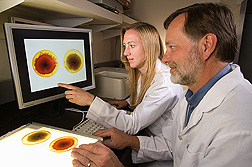Edible Fungus Could Help
Address Vitamin A Deficiency
According to the World Health Organization, vitamin A deficiency is a major public health concern in more than half of all countries, but especially those in Africa and Southeast Asia. In children, vitamin A deficiency is a leading cause of preventable blindness and increases the risk of illness and death resulting from severe infections such as diarrheal disease.
In poor, rural regions of Asia, villagers routinely eat “red rice,” a fermented dish containing the fungus Monascus purpureus—also known as “red rice yeast.” Its popularity in rice and other Asian foods gave ARS plant geneticist Daniel Z. Skinner—who knew of the fungus’s pigment-producing prowess—an idea. Why not substitute some of Monascus’s genes for two from another fungus, Blakelslea trispora, which produces beta-carotene, a pigment the human body readily converts to vitamin A? If such a biotechnological feat could be carried out, Skinner reasoned, perhaps a beta-carotene-producing strain could be substituted for the one now used in Asian foods, thus offering a way to address vitamin A deficiency in people en masse.
“Using the invention would require no change to the way M. purpureus is currently used, but rather would only require substitution of a beta-carotene-producing strain in all food-manufacturing processes,” says Skinner, research leader of ARS’s Wheat Genetics, Quality, Physiology, and Disease Research Unit in Pullman, Washington.
In studies with Cheryl Vahling, ARS molecular biologist, and Kamolnan Taweeyanyongkul, a collaborator with Mission College in Muak Lek, Saraburi, Thailand, Skinner used equipment popularly known as a “gene gun” to fire two copies of Blakelslea genes into the DNA of the red rice fungus, thus enabling it to make the orange-colored pigment.
“We think the fungus can make about as much beta-carotene as a carrot—when grown under the right conditions,” says Skinner. He began researching Monascus in 2002 as part of a broader program aimed at improving wheat’s productivity and quality for domestic food uses as well as export. USDA’s Foreign Agricultural Service provided funding for the project.
Monascus has a long and well-documented history of food and medicinal uses in Asia, but especially in China, where records of the fungus date back to the Tang Dynasty in 800 A.D. Monascus first came to the attention of Western society in the late 1880s, after it was isolated and scientifically described by Dutch scientists.
Besides cooked rice, “Other products include noodles made from rice, wheat, or other grains, and various meat and fish products that are fermented with M. purpureus to impart a desirable red color and modified flavor,” notes Skinner. “Color-variant strains are actively sought by those involved in the Asian food industry. The unique orange color of the beta-carotene-producing strain we’ve developed should be seen as a desirable attribute.”—By Jan Suszkiw, Agricultural Research Service Information Staff.
Daniel L. Skinner is in the USDA-ARS Wheat Genetics, Quality, Physiology, and Disease Research Unit, 209 Johnson Hall, Washington State University, Pullman, WA 99164; phone (509) 335-8696, fax (509) 335-2553.
"Edible Fungus Could Help Address Vitamin A Deficiency" was published in the May/June 2009 issue of Agricultural Research magazine.







